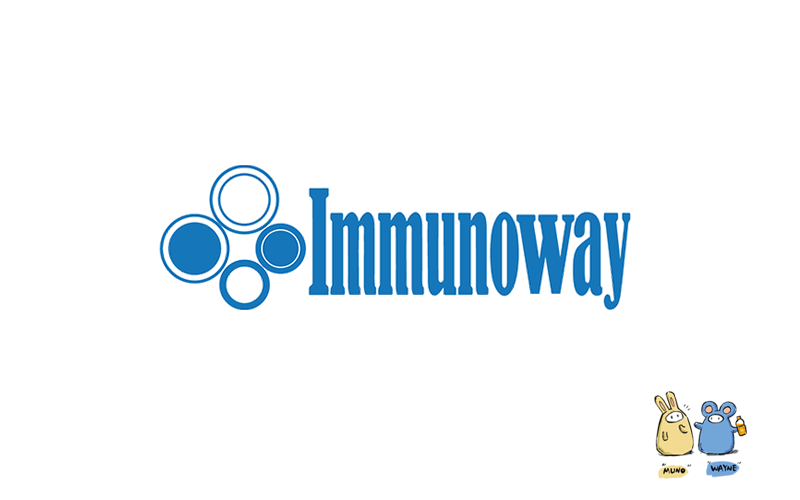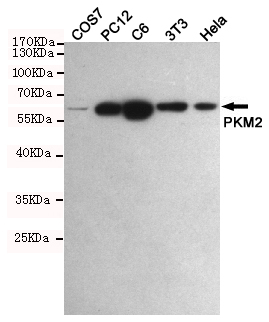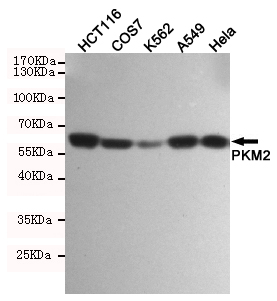
Catalog: YT3777
Size
Price
Status
Qty.
200μL
$450.00
In stock
0
100μL
$280.00
In stock
0
40μL
$150.00
In stock
0
Add to cart


Collected


Collect
Main Information
Target
PKM2
Host Species
Rabbit
Reactivity
Human, Mouse, Rat
Applications
IF, WB, IHC, ELISA
MW
58kD (Observed)
Conjugate/Modification
Unmodified
Detailed Information
Recommended Dilution Ratio
IF 1:50-200; WB 1:500-2000; ELISA 1:10000-20000; IHC 1:50-300
Formulation
Liquid in PBS containing 50% glycerol, 0.5% BSA and 0.02% sodium azide.
Specificity
PKM2 Polyclonal Antibody detects endogenous levels of PKM2 protein.
Purification
The antibody was affinity-purified from rabbit antiserum by affinity-chromatography using epitope-specific immunogen.
Storage
-15°C to -25°C/1 year(Do not lower than -25°C)
Concentration
1 mg/ml
MW(Observed)
58kD
Modification
Unmodified
Clonality
Polyclonal
Isotype
IgG
Related Products
Antigen&Target Information
Immunogen:
The antiserum was produced against synthesized peptide derived from human PKM2. AA range:181-230
show all
Specificity:
PKM2 Polyclonal Antibody detects endogenous levels of PKM2 protein.
show all
Gene Name:
PKM
show all
Protein Name:
Pyruvate kinase PKM
show all
Other Name:
PKM ;
OIP3 ;
PK2 ;
PK3 ;
PKM2 ;
Pyruvate kinase isozymes M1/M2 ;
Cytosolic thyroid hormone-binding protein ;
CTHBP ;
Opa-interacting protein 3 ;
OIP-3 ;
Pyruvate kinase 2/3 ;
Pyruvate kinase muscle isozyme ;
Thyroid hormone-binding protein 1 ;
THBP1 ;
Tu
OIP3 ;
PK2 ;
PK3 ;
PKM2 ;
Pyruvate kinase isozymes M1/M2 ;
Cytosolic thyroid hormone-binding protein ;
CTHBP ;
Opa-interacting protein 3 ;
OIP-3 ;
Pyruvate kinase 2/3 ;
Pyruvate kinase muscle isozyme ;
Thyroid hormone-binding protein 1 ;
THBP1 ;
Tu
show all
Database Link:
Background:
This gene encodes a protein involved in glycolysis. The encoded protein is a pyruvate kinase that catalyzes the transfer of a phosphoryl group from phosphoenolpyruvate to ADP, generating ATP and pyruvate. This protein has been shown to interact with thyroid hormone and may mediate cellular metabolic effects induced by thyroid hormones. This protein has been found to bind Opa protein, a bacterial outer membrane protein involved in gonococcal adherence to and invasion of human cells, suggesting a role of this protein in bacterial pathogenesis. Several alternatively spliced transcript variants encoding a few distinct isoforms have been reported. [provided by RefSeq, May 2011],
show all
Function:
Catalytic activity:ATP + pyruvate = ADP + phosphoenolpyruvate.,cofactor:Divalent metal cations.,cofactor:Magnesium.,cofactor:Potassium.,enzyme regulation:Isoform M2 is allosterically activated by D-fructose 1,6-biphosphate (FBP). Inhibited by oxalate and 3,3',5-triiodo-L-thyronine (T3).,Function:Glycolytic enzyme that catalyzes the transfer of a phosphoryl group from phosphoenolpyruvate (PEP) to ADP, generating ATP.,miscellaneous:There are 4 isozymes of pyruvate kinase in mammals: L, R, M1 and M2. L type is major isozyme in the liver, R is found in red cells, M1 is the main form in muscle, heart and brain, and M2 is found in early fetal tissues as well as in most cancer cells.,online information:Pyruvate kinase entry,pathway:Carbohydrate degradation; glycolysis; pyruvate from D-glyceraldehyde 3-phosphate: step 5/5.,PTM:Phosphorylated upon DNA damage, probably by ATM or ATR.,similarity:Belongs to the pyruvate kinase family.,subunit:Monomer and homotetramer. Exists as a monomer in the absence of FBP, and reversibly associates to form a homotetramer in the presence of FBP. The monomeric form binds T3. Tetramer formation induces pyruvate kinase activity. Interacts with HERC1.,
show all
Cellular Localization:
[Isoform M2]: Cytoplasm . Nucleus . Translocates to the nucleus in response to various signals, such as EGF receptor activation or apoptotic stimuli (PubMed:17308100, PubMed:22056988, PubMed:24120661). Nuclear translocation is promoted by acetylation by EP300 (PubMed:24120661). Deacetylation by SIRT6 promotes its nuclear export in a process dependent of XPO4, thereby suppressing its ability to activate transcription and promote tumorigenesis (PubMed:26787900). .; [Isoform M1]: Cytoplasm .
show all
Tissue Expression:
[Isoform M2]: Specifically expressed in proliferating cells, such as embryonic stem cells, embryonic carcinoma cells, as well as cancer cells. ; [Isoform M1]: Expressed in adult tissues (PubMed:18337823). Not expressed in tumor cells (PubMed:18337823).
show all
Research Areas:
>>Glycolysis / Gluconeogenesis ;
>>Pyruvate metabolism ;
>>Metabolic pathways ;
>>Carbon metabolism ;
>>Biosynthesis of amino acids ;
>>Glucagon signaling pathway ;
>>Type II diabetes mellitus ;
>>Human papillomavirus infection ;
>>Viral carcinogenesis ;
>>Central carbon metabolism in cancer
>>Pyruvate metabolism ;
>>Metabolic pathways ;
>>Carbon metabolism ;
>>Biosynthesis of amino acids ;
>>Glucagon signaling pathway ;
>>Type II diabetes mellitus ;
>>Human papillomavirus infection ;
>>Viral carcinogenesis ;
>>Central carbon metabolism in cancer
show all
Signaling Pathway
Reference Citation({{totalcount}})
Catalog: YT3777
Size
Price
Status
Qty.
200μL
$450.00
In stock
0
100μL
$280.00
In stock
0
40μL
$150.00
In stock
0
Add to cart


Collected


Collect
Recently Viewed Products
Clear allPRODUCTS
CUSTOMIZED
ABOUT US
Toggle night Mode
{{pinfoXq.title || ''}}
Catalog: {{pinfoXq.catalog || ''}}
Filter:
All
{{item.name}}
{{pinfo.title}}
-{{pinfo.catalog}}
Main Information
Target
{{pinfo.target}}
Reactivity
{{pinfo.react}}
Applications
{{pinfo.applicat}}
Conjugate/Modification
{{pinfo.coupling}}/{{pinfo.modific}}
MW (kDa)
{{pinfo.mwcalc}}
Host Species
{{pinfo.hostspec}}
Isotype
{{pinfo.isotype}}
Product {{index}}/{{pcount}}
Prev
Next
{{pvTitle}}
Scroll wheel zooms the picture
{{pvDescr}}






















